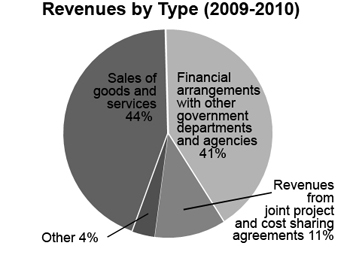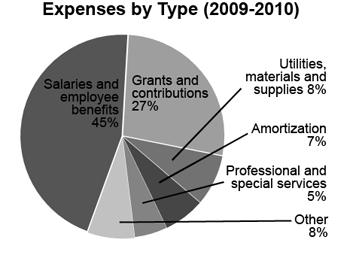Common menu bar links
Breadcrumb Trail
ARCHIVED - National Research Council Canada - Report
 This page has been archived.
This page has been archived.
Archived Content
Information identified as archived on the Web is for reference, research or recordkeeping purposes. It has not been altered or updated after the date of archiving. Web pages that are archived on the Web are not subject to the Government of Canada Web Standards. As per the Communications Policy of the Government of Canada, you can request alternate formats on the "Contact Us" page.
Section III – Supplementary Information
3.1 Financial Highlights
The following general overview of NRC's financial position and operations are presented on an accrual basis for comparability with the complete financial statements published on NRC's Web site.
| Condensed Statement of Financial Position At End of Year (March 31, 2010) |
% Change | 2009-2010 | 2008-2009 |
|---|---|---|---|
| Assets | |||
| Total Assets | (0.5 %) | 816,923 | 821,313 |
| Total | (0.5 %) | 816,923 | 821,313 |
| Liabilities | |||
| Total Liabilities | 1.9 % | 336,152 | 329,943 |
| Equity | |||
| Total Equity | (2.2 %) | 480,771 | 491,370 |
| Total | (0.5 %) | 816,923 | 821,313 |
| Condensed Statement of Operations At End of Year (March 31, 2010) |
% Change | 2009-2010 | 2008-2009 |
|---|---|---|---|
| Expenses | |||
| Total Expenses | 14.8 % | 1,032,652 | 899,430 |
| Revenues | |||
| Total Revenues | 8.6 % | 169,627 | 156,246 |
| Net Cost of Operations | 16.1 % | 863,025 | 743,184 |
Revenue is important to NRC, not only as a means of financing operating and capital expenditures, but also as an indication of the value that NRC provides to its clients and collaborators. NRC earned total revenues of $169.6 M in 2009-2010, up from $156.2 M in 2008-2009. NRC's largest component of revenue results from the sale of goods and services at $74.7 M, primarily consisting of research services provided to industry and academic clients ($49.6 M), with the remaining balance provided by the sale of goods and information products ($11.7 M), NRC rights and privileges ($8.9 M) and lease and use of property ($4.5 M), all calculated on an accrual basis.

NRC incurred total expenses of $1,033.7 M in 2009-2010, up from $899.4 M in 2008-2009. NRC's major expense components are salaries and employee benefits ($468.3 M) and grants and contributions ($281.2 M), representing 72.6% of total expenses. The $133.3 M increase results from NRC's participation with the implementation of Canada's Economic Action Plan. In total, NRC received and spent an additional $142.5 M in grants and contributions as a result of Canada's Economic Action Plan in order to support scientific research and development activities performed by Canadian organizations during 2009-2010.

3.2 List of Supplementary Information Tables
The following tables are located on the Treasury Board Secretariat Web site:
- Sources of Respendable and Non-Respendable Revenue
- User Fees/External Fees
- Details on Transfer Payment Programs (TPPs)
- Horizontal Initiatives
- Green Procurement
- Response to Parliamentary Committees and External Audits
- Internal Audits and Evaluations
3.3 Other Items of Interest
3.3.1 NRC Council Members
NRC's Council provides strategic direction and advice to the President and monitors progress against strategic plans. The Minister of Industry may also consult the NRC Council for advice on matters that affect NRC and that are of importance to science and technology in Canada. The Council usually meets three times a year and has three standing committees: the Executive Committee, the Human Resources Committee and the Finance Committee. The Council is chaired by the President of NRC and the other members are appointed by the Government of Canada for three-year terms. Current members are as follows. An updated list is maintained on the NRC Web site along with biographies of the members.
John McDougall,
President (and Chair of Council), National Research Council Canada,
Ottawa, Ontario
Dennis Anderson,
Former President, Brandon University, and Management Consultant,
Gimli, Manitoba
Jacques Beauvais,
Vice Provost of Research, Universit� de Sherbrooke
Sherbrooke, Qu�bec
Paul Clark,
Former Vice-President, Research and Technology, NOVA Chemicals Corporation,
Calgary, Alberta
Peter Frise,
Scientific Director and CEO, Auto 21, University of Windsor,
Windsor, Ontario
Alexandre Jodoin,
Materials and Structures Engineer, BMT Fleet Technology Limited,
Manotick, Ontario
Jay Josefo,
Lawyer,
Toronto, Ontario
Raymond Leduc,
Director and Senior Location Executive, IBM Bromont,
Bromont, Qu�bec
Margaret Lefebvre,
Executive Director, Canadian Association of Income Funds,
Montr�al, Qu�bec
Kellie Leitch,
Associate Professor, Dept. of Surgery, University of Toronto, and Centre for Health Innovation & Leadership, Richard Ivey School of Business, University of Western Ontario,
Toronto, Ontario
Douglas MacArthur,
President, MacArthur Group, Inc.,
Charlottetown, Prince Edward Island
Eva Mah Borsato,
President, Intellectual Capital Corporation Inc.,
Edmonton, Alberta
Cecil Rorabeck,
Professor, Orthopaedic Surgery (Emeritus),
London, Ontario
Leo Steven,
Chairman, Health PEI,
Cardigan, Prince Edward Island
Iain Stewart,
Associate Vice-President, Research, Dalhousie University,
Halifax, Nova Scotia
Howard Tennant,
President Emeritus, University of Lethbridge,
Lethbridge, Alberta
Normand Tremblay,
Strategic Management Consultant, Normand Tremblay and Associates,
Montr�al, Qu�bec
Allan Warrack,
Professor of Business Emeritus, University of Alberta,
Edmonton, Alberta
David Wood,
Head of Finance and Corporate Development, Secretary and Treasurer, Celator Pharmaceuticals Inc.,
Vancouver, British Columbia
3.3.2 Online References
http://www.actionplan.gc.ca/eng/index.asp
http://www.nrc-cnrc.gc.ca/eng/reports/2009-2010/dpr-index.html
http://laws.justice.gc.ca/eng/N-15/index.html
http://www.tbs-sct.gc.ca/reports-rapports/cp-rc/2008-2009/cp-rctb-eng.asp
http://www.ic.gc.ca/eic/site/ic1.nsf/eng/h_00231.html
http://www.nrc-cnrc.gc.ca/eng/locations/index.html
http://www.nrc-cnrc.gc.ca/eng/business/colocating.html
http://www.nrc-cnrc.gc.ca/eng/evaluation/evaluation.html
http://www.labcanada.com/issues/story.aspx?aid=1000341991
http://www.nrc-cnrc.gc.ca/eng/news/irap/2009/07/07/avalon-microelectronics.html
http://www.nrc-cnrc.gc.ca/eng/ibp/irap.html
http://safstl-asbstf.scitech.gc.ca/eng/news/2010-04-29-fsel-licence-agreement.html
http://nparc.cisti-icist.nrc-cnrc.gc.ca/npsi/ctrl?lang=en
http://www.tbs-sct.gc.ca/dpr-rmr/2009-2010/index-eng.asp
http://www.nrc-cnrc.gc.ca/eng/about/council-members.html
1 Met All: "100 per cent of the expected level of performance (as evidenced by the indicator and target or planned activities and expected outputs) for the expected result or priority identified in the corresponding RPP was achieved during the fiscal year."
2 Based on data for total Canadian industrial R&D for 2003 and 2009 – see Table 1 in Statistics Canada Publication 88-202- x - Industrial Research and Development: Intentions, 2009. Constant dollar amounts for 2009 were calculated using the GDP deflator for that year.
3 A description of this program activity is available in Section 1.2.
4 Exceeded: "More than 100 per cent of the expected level of performance (as evidenced by the indicator and target or planned activities and outputs) for the expected result or priority identified in the corresponding RPP was achieved during the fiscal year."
5 "A Bibliometric and Technometric Analysis of the National Research Council Canada (1997-2008)" (Science-Metrix, 4 December 2009)
6 Bibliometric Analysis of the Scientific Production of the National Research Council of Canada, 1980-2007" (Observatoire des sciences et des technologies, July, 2008)
7 This data was not collected in 2007-2008. The value shown is estimated by linear regression.
8 A description of this program activity is available in Section 1.2.
